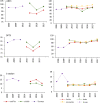Health services for women, children and adolescents in conflict affected settings: experience from North and South Kivu, Democratic Republic of Congo
- PMID: 32514296
- PMCID: PMC7254646
- DOI: 10.1186/s13031-020-00265-1
Health services for women, children and adolescents in conflict affected settings: experience from North and South Kivu, Democratic Republic of Congo
Abstract
Background: Insecurity has characterized the Eastern regions of the Democratic Republic of Congo for decades. Providing health services to sustain women's and children's health during protracted conflict is challenging. This mixed-methods case study aimed to describe how reproductive, maternal, newborn, child, adolescent health and nutrition (RMNCAH+N) services have been offered in North and South Kivu since 2000 and how successful they were.
Methods: We conducted a case study using a desk review of publicly available literature, secondary analysis of survey and health information system data, and primary qualitative interviews. The qualitative component provides insights on factors shaping RMNCAH+N design and implementation. We conducted 49 interviews with government officials, humanitarian agency staff and facility-based healthcare providers, and focus group discussions with community health workers in four health zones (Minova, Walungu, Ruanguba, Mweso). We applied framework analysis to investigate key themes across informants.The quantitative component used secondary data from nationwide surveys and the national health facility information system to estimate coverage of RMNCAH+N interventions at provincial and sub-provincial level. The association between insecurity on service provision was examined with random effects generalized least square models using health facility data from South Kivu.
Results: Coverage of selected preventive RMNCAH+N interventions seems high in North and South Kivu, often higher than the national level. Health facility data show a small negative association of insecurity and preventive service coverage within provinces. However, health outcomes are poorer in conflict-affected territories than in stable ones. The main challenges to service provisions identified by study respondents are the availability and retention of skilled personnel, the lack of basic materials and equipment as well as the insufficient financial resources to ensure health workers' regular payment, medicaments' availability and facilities' running costs. Insecurity exacerbates pre-existing challenges, but do not seem to represent the main barrier to service provision in North and South Kivu.
Conclusions: Provision of preventive schedulable RMNCAH+N services has continued during intermittent conflict in North and South Kivu. The prolonged effort by non-governmental organizations and UN agencies to respond to humanitarian needs was likely key in maintaining intervention coverage despite conflict. Health actors and communities appear to have adapted to changing levels and nature of insecurity and developed strategies to ensure preventive services are provided and accessed. However, emergency non-schedulable RMNCAH+N interventions do not appear to be readily accessible. Achieving the Sustainable Development Goals will require increased access to life-saving interventions, especially for newborn and pregnant women.
Keywords: Child; Conflict; Democratic Republic of Congo; Health services; Maternal; Newborn; North Kivu; Population displacement; Reproductive health; South Kivu; health system.
© The Author(s) 2020.
Conflict of interest statement
Competing interestsThe authors declare that they have no competing interests.
Figures





References
-
- Stearns J. North Kivu: the background to conflict in north Kivu province of eastern Congo [Internet]. London - Nairobi. 2012.
-
- Stearns J, Vogel C. The landscape of armed groups in eastern Congo. 2017.
-
- OCHA . DRC - Apercu des besoins humanitaires. 2017.
-
- OCHA . DRC - Apercu des besoins humanitaires. Kinshasa. 2018.
-
- OCHA . Democratic Republic of the Congo: Internally Displaced Persons and Returnees. 2017.
LinkOut - more resources
Full Text Sources

